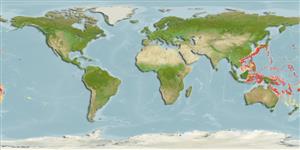Environment: milieu / climate zone / depth range / distribution range
Ecologie
marien demersaal; diepte 148 - 956 m (Ref. 116586). Tropical
Disjunct distribution: Northwestern Pacific off southern Japan, Taiwan and the northern Philippines and Southwestern Pacific from the Coral Sea to Vanuatu; none from the tropical low latitudes.
Grootte / Gewicht / Leeftijd
Maturity: Lm ? range ? - ? cm
Max length : 11.0 cm SL mannelijk / geslacht onbekend; (Ref. 116586)
Korte beschrijving
Determinatiesleutels | Morfologie | Morfometrie
Anale stekels: 3; Anale zachte stralen: 6. This deep-bodied species is distinguished by the following characters: convex dorsal head profile; A III + 6 in >6.5 cm SL specimens; pectoral-fin rays 16-18 with length 21.5-27% SL; gill rakers 15-18; pseudobranchial filaments 16-23, increasing with size; first anal-fin pterygiophore is long, slightly forward bent, with very broad tip and hollow; ectopterygoid with a single row of denticles; orbit diameter 11.7-13.3% SL; otolith compressed (OL:OH = 1.45-1.55) (Ref. 116586).
Found on the continental slope (Ref. 75154).
Levenscyclus en paargedrag
Maturiteit | Voortplanting | Paaien | Eieren | Fecunditeit | Larven
Schwarzhans, W.W. and A.M. Prokofiev, 2017. Reappraisal of Synagrops, Günther, 1887 with rehabilitation and revision of Parascombrops Alcock, 1889 including description of seven new species and two new genera (Perciformes: Acropomatidae). Zootaxa 4260(1):1-74. (Ref. 116586)
Status op de Rode Lijst van het IUCN (Ref. 130435: Version 2024-2)
Gevaar voor de mens
Harmless
Gebruik door de mens
Tools
Speciale rapporten
Download XML
Internetbronnen
Estimates based on models
Preferred temperature (Ref.
123201): 15.3 - 26.8, mean 22.3 °C (based on 220 cells).
Fylogenetische diversiteitsindex (Ref.
82804): PD
50 = 0.5001 [Uniqueness, from 0.5 = low to 2.0 = high].
Bayesian length-weight: a=0.00977 (0.00436 - 0.02192), b=3.01 (2.81 - 3.21), in cm total length, based on LWR estimates for this (Sub)family-body shape (Ref.
93245).
Trofisch niveau (Ref.
69278): 3.5 ±0.5 se; based on size and trophs of closest relatives
Fishing Vulnerability (Ref.
59153): Low vulnerability (10 of 100).
